
with Otmar Szafnauer
Atlas F1 Editor in Chief
A Rumanian, a German and an American walk into a BAR... The path of Honda Racing Development's vice president Otmar Szafnauer into Formula One sounds almost like a typical joke, except that the modest American-Rumanian born is one of the most versatile, serious and interesting men in F1. Biranit Goren interviewed the former engineer and racer who once dreamt of being a world champion, about Sato's engine blow ups, BAR-Honda's newfound success, the advantage of Friday practice, and childhood between the Iron Curtain and Motor City in Detroit. Exclusive for Atlas F1
Honda Racing's Vice President, Otmar Szafnauer, has a different theory on that.
"When I was in university," he says, "I ran a computer programme that flipped a coin a million times. I was going to Las Vegas for a friend's bachelor's party and I wanted to win at the casinos. So I had this theory that if I doubled my bet on a fifty-fifty bet, I would almost never lose – when you lose you double until you win. And in the million flips, I came across many rows of heads or tails – the longest string I saw was twenty nine, which would have bankrupted me, so I decided not to use the strategy.
"But there were little rows of fives - so even if it's fifty-fifty, three in a row is quite easy to happen. Even though getting two heads in a row before you start, I think the probability is 25%, three is 12.5%, and then it really gets down quickly, so twenty nine in a row you'd think would be almost nothing, but it happens."
Q: Well you've got to hope Sato is not going to get twenty nine engine failures!
Szafnauer laughs. "No, exactly! My point is, say he got seven, and it is a fifty-fifty shot, then everyone would say 'oh there's got to be a difference [between the cars or drivers]' – well, there doesn't have to be; it's a rare event where you can get seven heads in a row, but it can happen. After you've had four of them, the next one is fifty-fifty."
The problem with that theory, though, is that engines are not supposed to explode in a season where the rules force the teams to run with one engine per car for an entire Grand Prix weekend. So the questions are twofold: why does Honda have reliability problems, and why these problems seem to inflict only one driver. The Japanese car maker doesn't have a clear answer to either questions.
"There was nothing to indicate why it should happen, and why it happens to one car rather than the other," Szafnauer commented after Montreal, where Sato retired with a blown engine for the third consecutive race. "The traction control is the same, the override controls are the same – everything is the same with the two cars."
Q: BAR's technical director Geoff Willis stated that Sato is slightly harder on the car than Button, in their driving style. Could that have anything to do with it?
It was just as well that Sato never got around to testing the margins of error in Szafnauer's statistical coin toss experiment, and it would of course be all too easy to criticise BAR-Honda for bringing both cars to the finish in only three of the nine Grands Prix - especially when they have been the primary team this season to get even remotely close to Ferrari. If it wasn't for their lack of reliability, BAR would have undoubtedly now been second in the Constructors' Championship. Instead, they're only third. Only?
It's easy to forget, looking at BAR-Honda today, their appalling reliability and lack of results in previous years, despite an impressive budget, a fully backed factory engine, and a World Champion at the wheel. It's easy to forget, looking at the BAR celebrations under the podium almost every Sunday this year, how much in-fighting and politics have marred that team in its first five years. And it's easy to expect them to do more when they're the revelation of a season that has seen the traditional Top Three hegemony all but vanish.
"I wouldn't say we're surprised at our success this year," Szafnauer says, "but I think we're a bit more pleased than we thought we'd be. Our target at the beginning of the year was to be among the top three - at this point in time, it looks like we have a chance in achieving that and perhaps surpassing that; we may, if all goes well, even be fighting with Renault for second."
Szafnauer can perhaps appreciate BAR's success this season more than many others. After all, he was involved in BAR when it was just founded - and working under Adrian Reynard in establishing the new team was his first job in Formula One.
From Trabant to Reynard
In a paddock that is largely made up of European nationalities, and in a company that is primarily Japanese, Szafnauer stands out for more than just his unique name and physical height - or his versatile experience as a businessman, an engineer and a racing driver. The amicable 40-year-old is one of the very few Americans working in Formula One, certainly the most senior in the paddock. And his biography and path into the pinnacle of motor racing is anything but conventional.
He was born in Rumania in 1964, to a Rumanian mother and a German father whose own father had moved to Germany from New York. And it wasn't until young Szafnauer was eight years old that his family moved back to the United States, but not without difficulties.
"He was put on trial and his defence was that he was a US citizen living in Rumania. He applied many times to the government to leave with that rationale, but they just dismissed it. Eventually they put him in jail for about a year and then they let us leave for the US."
Despite a long ancestry in New York, the Szafnauers moved to Detroit, Michigan, "because my father was a tool-maker and thought he would find a job in Detroit because of the auto industry." In fact, Szafnauer recalls, his father was one of the few people in Rumania back then to have owned a car. "There were only a couple of people who had a car in our town - I think the other person was the town doctor or something," he recalls.
"My dad won the car in some lottery, and he always thought that the draw was fixed by the government in order to stop him from trying to leave the country! Well, it was a two cylinder Trabant, with a little four-speed gearbox, papier-mache panels and stuff, and my dad would always tinker with it as there was no chance of anyone else fixing it. He had to learn to do it by himself - especially as it wasn't all that reliable. So he was always fixing it."
With oil pumps and spark plugs lying around the house, Szafnauer was inevitably drawn to motor racing, although it wasn't until at a much later age that he could afford to actually participate in races.
"Once we got to America, it was very difficult financially for my dad," he explains. "I played soccer because all it required was a pair of boots - if I wanted to play ice hockey, which I loved, I couldn't afford it, and there was absolutely no chance of me racing, zero, until I could afford it myself."
And so, at the tender age of 23, Szafnauer went to the Jim Russel school of motor racing at Laguna Seca, after which he began racing F2000 cars. You would think at that age, Szafnauer would consider racing only a hobby, but, he says, laughing, "I didn't think so, I thought I was going to be a World Champion!"
To finance his racing ("I was sponsored by RRP - Right Rear Pocket") Szafnauer, who studied engineering, began working at the Ford Motor Company. With the money he saved, he bought a '91 Reynard from a fellow Canadian racer, and once a month he would drive into work on Wednesday morning with a truck and immediately after work would drive with his mechanic to the next race venue.
At the age of 31, then, Szafnauer finally accepted that a World Champion driver he won't be, and he instead focused on making a career for himself at Ford, shortly before he was lured into the Formula One paddock.
"I never had my sights set on Formula One - I wanted to rise through the ranks at Ford and do as well as I could do there," he explains. "At the time, Ford was reorganising, and under that reorganisation came a group called The New Concepts Organisation, which was meant to be a place for people to come up with exciting projects. So with my racing background, I was assigned to that group, to be the sports and performance manager. I had to come up with concepts for sports and performance, and the first thing I had was the Indygo."
The Indygo was an ambitious Ford concept for a side-by-side two-seater Indy car for street use. Ford's official press releases at the time stated the car "captures the essence of the race track and transforms it into a realistic design for the street." It was powered by a 6.0 litre V12 unit (made of two V6 units combined together) and produced a reported 435 bhp - with top speed of 275 km/h. The price tag was set to be $100,000 US.
It was there, in working on the Indygo concept, that Szafnauer met the man who would eventually bring him into Formula One. "We hired Adrian Reynard to design and build the car and I worked with him at that year, so when the opportunity came to start BAR and he had to hire 200 technical staff, he called me and invited me to join them to construct his management team," Szafnauer explains plainly.
"At first I didn't want to come - I thought, well, I know where my career path's going at Ford; Formula One is risky; I worked for 12 years in the same company and now I'm going to throw that out for racing? I knew the business - racing is a flaky business and things change every year."
It certainly did for Szafnauer who, over a year after joining BAR was asked by his friend Bobby Rahal to come work with him at Jaguar Racing, only to find that his new boss was fired a week before he was supposed to begin working there himself. But, as luck and fate would have it, even that turned out for the best, as Honda were eager to have the business, engineering and marketing savvy American onto their third generation return to Formula One.
"So I was 100% right: in my first four years in F1 I had three jobs!" Szafnauer laughs. "I was at BAR for over a year, then at Jaguar for minus one week, and now at Honda. So my fears were right but, looking back, I made the right decision."
Turning Japanese
There are not many senior members at BAR today who were there six years ago, when the team was founded by Reynard and Craig Pollock, with 1997 World Champion Jacques Villeneuve signed as their hottest commodity. Not even Honda were at the frame in the beginning. And what a disastrous beginning it was.
Reynard and Pollock have by now long gone, relieved of their duties at the team and unburdened of their shares at the company. But Szafnauer, now as vice president of Honda Racing, gets to enjoy the turnaround of the team's fortunes - which is more than could be said of Villeneuve who, at the end of last year and after five miserable seasons at BAR, was told his contract would not be renewed, leaving him without a drive this season.
"I feel for him, absolutely," Szafnauer states. "Jacques did a lot of hard work for the team, and you can't help look back and think 'what if'. Because we didn't give him the best package - that's a fact." But Szafnauer rebuffs any suggestions that the Canadian driver was somehow pushed out by Honda before the final race of the 2003 season, in order to make way for Sato.
"It was entirely his decision," Szafnauer says emphatically. "Saying that we had a hand in this is wrong. Look, I know what it's like to race: if you're not feeling up to the job, even the smallest distraction can be disastrous. You've got to have a 100% focus on the job at hand. So when Jacques said he doesn't want to drive, you had to respect that."
Either way, BAR without Villeneuve and with a newfound success is a whole new team, and Szafnauer confirms the organisation has finally come of age, with a better integration between Honda and BAR.
"Yes, our relationship has come of age," he says. "It's progressed to the point where we're more fully integrated. For instance, we used to run a wind tunnel in Japan, with Honda employees looking at aero developments and advances of the car, and then asked Brackley to look at it. Now, many of the Japanese have come over [to England] and work in the Brackley tunnel, integrated within the aero department. So this is the first year where we're working in that way, and that has really, really helped.
Q: BAR, Renault and Williams seem to be very close this year. How did you prepare for this season, and how do you plan to stay ahead?
"As far as engine goes, this year our plan was different than in previous years. In the past, every time we found an improvement in the engine we wanted to bring it out as quickly as we could. And this philosophy comes from Mr. Honda, who believed that if you find an advantage that you can put in your product, it's a sin not to give it to your customer as soon as you can. That was his mentality. And that mentality went into F1 as well, so whenever we found whatever bit of horsepower that was, or weight reduction - as soon as you can, get it to the team.
"This year we're doing it differently. We're up there with power, so we said now let's look at bunching some of the findings into bigger steps but less frequent. So that's how we're trying to progress this year. And the last engine upgrade we've had was in Montreal. But reliability is now more paramount - you pay a bigger price for an engine failure than before, and it means you have to do more analysis, make sure the reliability is there before you introduce your next step. It means bigger steps but less often. And it means a lot more testing - in the factory and, more importantly, testing on track. Before you introduce anything, you've got to run it 800-1000kms to just do one weekend's worth of analysis, whereas before if you got it to 400kms that was enough. Now it takes longer."
Q: Could it also be that you have an advantage by running a third driver in Friday's practice? This rule was put in place last year to help the bottom six teams. As it panned out, you're hardly a bottom six team and some - like David Coulthard - believe the rule is giving you an unfair advantage
Szafnauer: "Well, it is an advantage, technically it definitely gives you an advantage - you can do different things, mainly assessing tyres. But I think the success we've had this year is attributed to many, many things that we did over the winter. Part of it - a small part of it - is that we can learn a bit more with the third driver [on Fridays], especially about tyre choice. This is our first year with Michelin tyres, so we have a lot to learn about how to use the tyres to our advantage, how to best get the performance out of our tyres, and Anthony [Davidson] does help with that.
"So it's never a controlled experiment, you could never say let's look back, take Anthony away and how would you have done? I would imagine we would not be as well off as we are today, but just marginally. Most of the success has come from hard work in the wind tunnel, getting the engine ready early, a lot of testing in the winter, lower centre of gravity in the engine, more power - I mean, that's what really does it."
Q: So how do you rate your engine today, then, compared to the other teams?
Szafnauer shifts uncomfortably. Honda people are not known to brag, and there is a sense of modesty in how they go about doing their work. In that respect, Szafnauer is certainly turning Japanese. "That's difficult to say - we try to ask other people what their impression is, because they talk to the other teams more," he says, smiling.
"But I would feel comfortable saying we are if not the best, among the best. Definitely top three, if not the best engine out there."
And now, if they could just grab that first Honda win since 1992 - or at least get two cars to finish in the points together, consistently - everything will be just perfect.
When Takuma Sato stepped on the podium at the Indianapolis Motor Speedway - equalling the achievement of Aguri Suzuki as the only Japanese driver to finish in the top three - you could almost hear the collective sigh of relief at Honda. For a change, their brilliant yet over-enthusiastic compatriot was making the headlines for the right reasons, and not because another one of their engines had seen him retire with a bang.
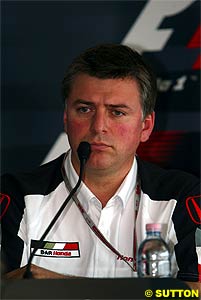 Five times did Sato retire with an engine failure this season - five times where his teammate Jenson Button went on to finish on the podium. And despite the electronic gizmos that should prevent a driver from having any effect on the engine's reliability, speculations were inevitable that Sato was the differing factor between the two BAR engine units - and perhaps he had stressed the engine by overdriving it.
Five times did Sato retire with an engine failure this season - five times where his teammate Jenson Button went on to finish on the podium. And despite the electronic gizmos that should prevent a driver from having any effect on the engine's reliability, speculations were inevitable that Sato was the differing factor between the two BAR engine units - and perhaps he had stressed the engine by overdriving it.
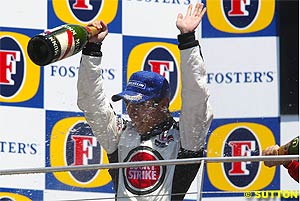 Szafnauer: "Harder on the car means how late you brake, how hard you turn in and how smooth you are. From an engine perspective it shouldn't make a difference – you can be hard on the car, but the engine just sees the same thing: full throttle, off the throttle, and it's all mapped with rev limiters and everything. I mean, that's what it's built to do."
Szafnauer: "Harder on the car means how late you brake, how hard you turn in and how smooth you are. From an engine perspective it shouldn't make a difference – you can be hard on the car, but the engine just sees the same thing: full throttle, off the throttle, and it's all mapped with rev limiters and everything. I mean, that's what it's built to do."
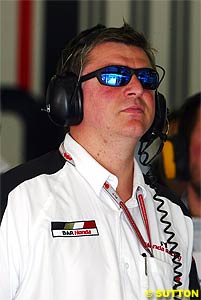 "From very early on, my father wanted to leave Rumania, but the authorities wouldn't let him," Szafnauer recalls. "Eventually he tried to escape in 1971 - when I was about seven years old. I remember two police officers coming to our house in the morning as I was leaving for school, and I thought, that's odd, policemen? Here? But it was because they had just caught my dad trying to escape the country. Luckily he didn't get shot, because often times at the border they'd shoot you.
"From very early on, my father wanted to leave Rumania, but the authorities wouldn't let him," Szafnauer recalls. "Eventually he tried to escape in 1971 - when I was about seven years old. I remember two police officers coming to our house in the morning as I was leaving for school, and I thought, that's odd, policemen? Here? But it was because they had just caught my dad trying to escape the country. Luckily he didn't get shot, because often times at the border they'd shoot you.
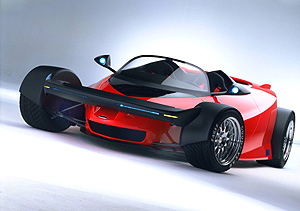 Szafnauer raced until 1995 - in fact, his last appearance took place the day before Jacques Villeneuve, with whom he would later work at BAR, won the Indianapolis 500. "I entered in an event called 'The Night Before the 500', but I hit the wall in pre-qualifying, so I didn't make it to the final. I wasn't injured, but the car was injured and my wallet was devastated!" he laughs.
Szafnauer raced until 1995 - in fact, his last appearance took place the day before Jacques Villeneuve, with whom he would later work at BAR, won the Indianapolis 500. "I entered in an event called 'The Night Before the 500', but I hit the wall in pre-qualifying, so I didn't make it to the final. I wasn't injured, but the car was injured and my wallet was devastated!" he laughs.
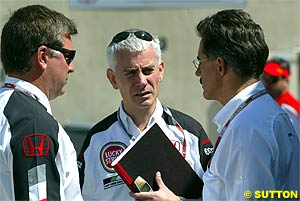 "Our challenges were massive," Szafnauer recalls. "There were not enough people and I think we had 40% of the staff of the rest of the grid. When I got in, at August, I was the 70th employee. Only six months before there were three employees. And when I got there, the car was already designed. Everyone else had about 300 people."
"Our challenges were massive," Szafnauer recalls. "There were not enough people and I think we had 40% of the staff of the rest of the grid. When I got in, at August, I was the 70th employee. Only six months before there were three employees. And when I got there, the car was already designed. Everyone else had about 300 people."
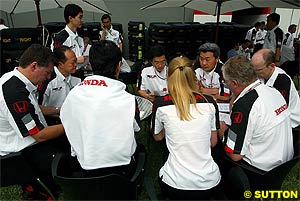 Szafnauer: "Well, when we were looking at the upcoming season - because we were fifth last year - we said our target is going to be third, and we knew we had to make bigger steps relative to the others to get there. So we planned out what our steps are going to be, and obviously that worked for us. But now, during the season, you're a bit limited by what you can do because the general package is there - so you have to improve on that package. You have to work hard on progressing that package - with aerodynamic and engine upgrades. So, for example, we have a big aerodynamic upgrade coming at Silverstone.
Szafnauer: "Well, when we were looking at the upcoming season - because we were fifth last year - we said our target is going to be third, and we knew we had to make bigger steps relative to the others to get there. So we planned out what our steps are going to be, and obviously that worked for us. But now, during the season, you're a bit limited by what you can do because the general package is there - so you have to improve on that package. You have to work hard on progressing that package - with aerodynamic and engine upgrades. So, for example, we have a big aerodynamic upgrade coming at Silverstone.
|
Contact the Author Contact the Editor |
Please Contact Us for permission to republish this or any other material from Atlas F1.
|
Volume 10, Issue 26
Atlas F1 Exclusive
Interview with Otmar Szafnauer
Bjorn Wirdheim: Going Places
Atlas F1 Special
2004 Half-Term Technical Report
2004 French GP Preview
2004 French GP Preview
French GP Facts & Stats
The F1 Trivia Quiz
Columns
Rear View Mirror
Bookworm Critique
Elsewhere in Racing
> Homepage |